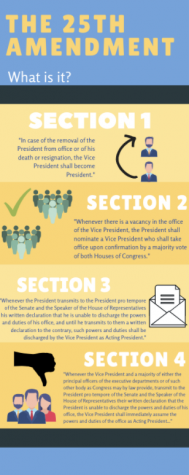Explaining the 25th Amendment
January 14, 2021

Ratified in 1967, The 25th Amendment was debated being put to use after the disaster at the Capitol Building, although Pence has denied this approach. But what exactly does that mean?
The amendment was proposed due to the John F. Kennedy assassination. This led to the unfortunate realization that there wasn’t a clear plan as to who was to take over the Presidency because of the holes in the original Constitution.
The first of the four sections of the amendment simply states, “In case of the removal of the President from office or of his death or resignation, the Vice President shall become President”.
This section has only been used when a President resigned such as when Nixon resigned in 1974, the Vice President stepped into the role of President. As of now, no Presidents have died in office since the passing of this amendment.
Section 2 states that a President must nominate a new Vice President if it becomes necessary and both Congress and the Senate must approve. This has happened when Vice Presidents have resigned from their positions like the case in 1973 when VP Spiro Agnow resigned and was replaced by Gerald Ford.
An article by the National Constitution Center explains “when Ford took over the presidency the following year, he promptly invoked Section 2 to nominate Nelson Rockefeller to fill the resulting vice-presidential vacancy”.
The third section states that a President can temporarily give the Vice President presidential power with a written declaration. This has been used when Presidents have fallen ill or been in a situation where they were unfit to properly fulfill their duties.
Finally, section 4, which has still never been invoked before, offers the procedure if a President cannot or will not step out of their position.
The Vice President and majority of the cabinet members must make the initial decision deeming the President unfit and immediately making the VP Acting President. If the President defends himself, the cabinet has 4 days to reconsider their accusation. If they do, the President resumes his role, if they don’t, the VP keeps as Acting President while Congress makes a decision.
A CNN article asserts that “the portion of the 25th Amendment that allows the vice president and Cabinet to remove the president had in mind a leader who was in a coma or suffered a stroke.”
However, today’s situation is unprecedented so an unprecedented approach might be necessary.
“I never really knew what the 25th amendment was about before people started talking about using it now,” said Tommy Balestreri ‘23.
The amendment seems very rarely discussed until it is actually being put to use. There are indeed holes that the amendment itself creates and those are left up to those in power to interpret for themselves. Although it doesn’t look like this amendment will be put to use anytime soon, it’s not everyday one sees the succession happen first-hand.




